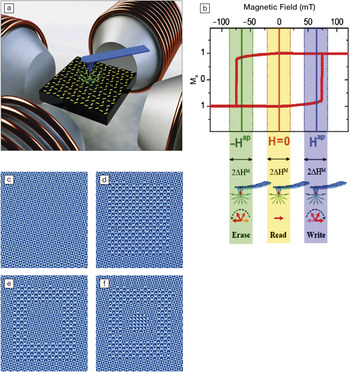Magnetic-storage devices, such as those used in computer hard disks, function on the binary principle—each of the two magnetic polarities represents 1 or 0. In order to increase storage capacity and functionalities, researchers have been studying artificial spin ices—structures wherein the constituents obey analogs of Pauling’s ice rule that dictates the positioning and ordering of protons in water ice. Artificial spin ices are magnetic systems with single-domain ferromagnetic nanostructures that have potential applications in data storage, memory, and logic devices.
Traditional artificial square spin ices have single-domain magnetic islands with only two ordered states, the magnetic moments either point inward or outward at the vertex of a square lattice. The large energy barrier required to rearrange the islands at room temperature limits the configuration of multiple ordered states for magnetic-storage applications. However, the assumption here is that connections between the pairs of positive and negative magnetic charges in spins cannot be altered.
In a recent issue of Science (doi: 10.1126/science.aad8037), a research team led by Yong-Lei Wang and Zhi-Li Xiao in the Materials Science Division at Argonne National Laboratory, proposed and validated a theoretical, artificial, magnetic charge ice structural design. The new structure suggests a different pattern of connections between magnetic charge pairs, leading to eight possible ordered states that could be controlled by external magnetic fields. These additional ordered states could provide a platform for designing future magnetic-storage devices.

Illustration of rewriteable magnetic charge ice through charge configuration. (a) Experimental setup for global and local charge manipulation in a customized magnetic force microscopy. (b) Magnetization loop for write, erase, and read modes of a single magnetic spin. (c) Magnetic force microscope images of patterned magnetic charge ice at ground state, (d) fourfold degenerate excited Type III state written at the center, where (e) a smaller square was erased back to ground state, and (f) a twofold degenerate excited Type II state was written on the erased area. Credit: Yong-Lei Wang and Zhi-Li Xiao.
“The novelty of this research is the new way of thinking: instead of focusing on spins, we tackled the associated magnetic charges that allow us to design and create artificial magnetic structures with more controllability,” says Wang, the corresponding author of this work. “This research not only introduces several new spin structures, but also provides a method for designing new artificial spin structures by decoupling spins and magnetic charges, which would greatly enrich the materials [selection] for [the] artificial spin ice community.”
A magnetic force microscope (MFM) was demonstrated to manipulate the charge ordering. A two-dimensional solenoid magnet can apply in-plane magnetic fields in any orientation for long-range tunability of the entire magnetic spin ice sample. For local patterning of several magnetic charges, a magnetic tip of the MFM generates stray fields that interact with individual magnetic charges. This provides write, erase, or read function by adjusting the applied fields with varying distance to the sample surface.
A baseline in-plane magnetic field reduces the activation threshold for switching the spin state first, then the magnetic tip applies a small additional field to trigger the switch, causing a “write” action. Reversing the applied field “erases” the switch, and turning off the applied field resembles the “read” mode.
“In principle, our artificial magnetic charge ice could benefit the investigations and applications in any two-dimensional materials systems that change properties in a magnetic field,” Wang says.
“The paper demonstrates a method of directly writing patterns into specific moments of an artificial ice array of nanomagnets,” says Peter E. Schiffer, professor of physics and Vice Chancellor for Research at the University of Illinois at Urbana-Champaign. “Through the clever use of array geometry and external magnetic field, this microscopic control opens the door to new flexibility in the study of artificial spin ice.”




